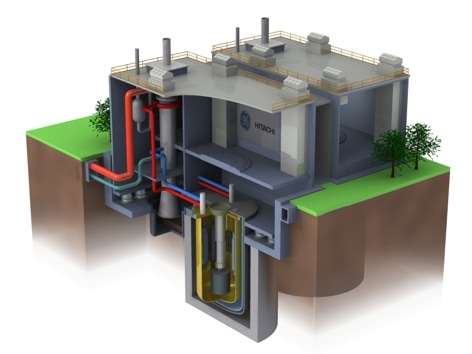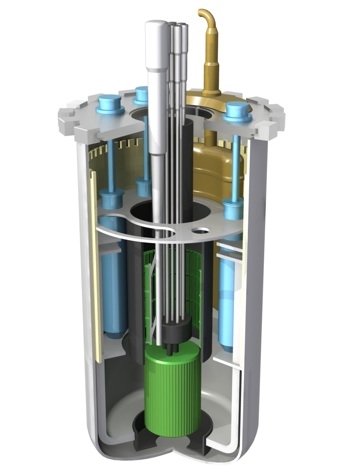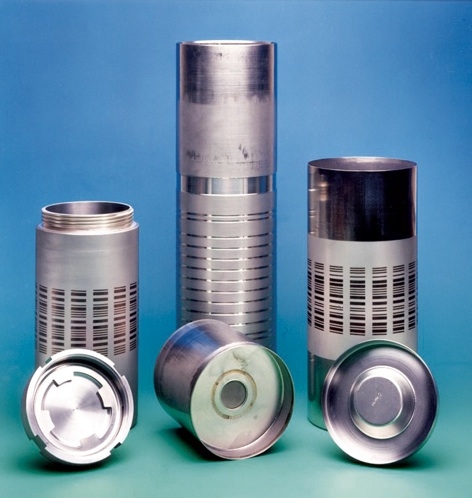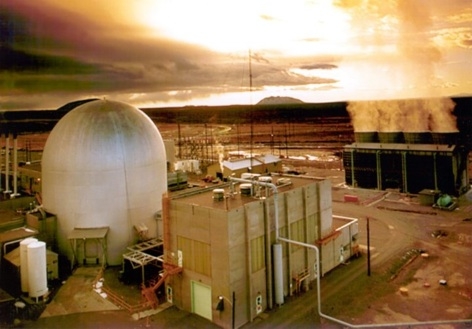Of all the issues facing the UK’s nuclear sector, the problem of plutonium is perhaps the trickiest. But a solution that could feed into a perceived need for the country to resume a position of developing and building new reactor technologies in the future is currently before the Nuclear Decommissioning Authority.
The UK has a lot of plutonium — the largest civil stockpile in the world, totalling some 112 tonnes, most of it from reprocessing spent fuel over the years. The question of what to do with Britain’s plutonium has vexed subsequent governments for decades. Should it be treated as waste and kept in storage until its radioactivity has transformed it into something less hazardous? Or, seeing as it is a fissile material, should it be treated as a fuel for future nuclear reactors? This has recently emerged as a favoured option, with the plutonium to be converted into a mixed metal oxide (MOX) fuel at an unspecified date; this fuel could be used to fuel conventional reactors, such as those planned for the UK’s new nuclear build. This would convert it into a spent fuel that would still need storage, but it would no longer pose a weapons risk.

But making MOX is not simple and the UK’s recent record is not good. A MOX plant at Sellafield, part of the THORP reprocessing facility, cost £1.2bn but only produced five tonnes of fuel per year for its first five years, despite a 120-tonne-per-year design capacity, and closed down owing to lack of customers. But there could be an alternative.
The Nuclear Decommissioning Authority is currently considering a 1,000-page report detailing a nuclear reactor called PRISM (Power Reactor Innovative Small Module). Developed by GE and now part of the GE Hitachi Nuclear Energy portfolio, PRISM is designed to run on fuels that would normally be considered waste products: the transuranic (that is, heavier than uranium) metals found in spent nuclear fuel, and plutonium.
The former of these are the elements with long-lived radioactivity, which makes spent fuel such a tricky proposition, and requires them to be stored securely for many thousands of years before their activity declines to the level of natural uranium ore. The latter, while equally unpleasant as a material, has the added hazard of the possibility of nuclear proliferation: primarily produced in military programmes, plutonium is the principal component of nuclear weapons.
PRISM reactors first hit the news in the UK when GE proposed building a PRISM ‘power block’ — a unit comprising two reactors and their associated steam-raising equipment — at Sellafield with the purpose of treating the plutonium stockpile. The block would be hooked up to a single turbine set, which would generate 622MW of electricity for the National Grid.

PRISM uses compact, metal-fuelled, sodium-cooled reactors of the type referred to as ‘fast’, which refers to the neutrons produced when their fuel undergoes fission. The reactors generally used for power generation, such as pressurised water reactors like Sizewell B or the advanced gas-cooled and Magnox reactors that make up the rest of the UK’s current reactor fleet, control the rate of the nuclear reaction by using moderators, such as water or compounds containing boron, which slow down the neutrons produced by fission. This leaves the neutrons with enough energy to be absorbed by uranium atoms to induce more fission.
Fast reactors, by contrast, don’t slow the neutrons down; they use coolants that do not interact with neutrons. The higher energy of the neutron allows different nuclear reactions to take place; notably, the transmutation from one element to another. This can turn a material that cannot undergo fission to one that can — in this case, the reactor is known as a breeder. Or it can induce a large, highly unstable nucleus, such as plutonium or other transuranics, into a smaller, less radioactive one — and this is the rationale behind the use of PRISM to treat plutonium.
Britain has experience with fast reactors; the facility at Dounreay, on Scotland’s north coast, operated two of them, both using a molten alloy of sodium and potassium (known as NaK) as a coolant. One used fuel in a metallic form, with coolant pumped around a loop; the other used oxide fuel with the coolant in a stirred pool. ‘PRISM is a unique distillation of the two reactorsat Dounreay and all the other 22 sodium-cooled reactors that are operating around the world,’ Eric Loewen, chief consulting engineer for GE Hitachi Nuclear Energy’s advanced plants technology division told The Engineer. ‘Very simply, it uses metallic fuel, has a pool design and, in terms of general nuclear reactor size, it’s small.’
The Dounreay reactors were breeders and PRISM originally emerged from breeder reactor research, part of the US Clinch River Breeder Reactor programme. This
programme and its successors ran until 1994, after which GE continued development of sodium-cooled breeders until 2001, before shelving it because it was deemed uneconomic.
‘In 2006 the US changed its policy framework on nuclear waste and we brought PRISM back onto the market as a way of treating transuranics in spent fuel,’ Loewen explained. ‘As a commercial company we respond to market drivers and in the case of nuclear power many of those drivers are set by government policy.’
GE offered PRISM technology to the UK because, Loewen said, it believes it offers a better way of treating the plutonium than converting it into MOX. Britain’s plutonium stockpile — officials bridle at referring to it as a ‘mountain’ — is stored at Sellafield, in an oxide-powder form, in reinforced concrete bunkers: there are more than 14,000 cans, each containing 7kg of oxide and each sealed inside two more cans. To make matters even more complicated, not every can contains the same isotope of plutonium. Different reactor processes produce different isotopes; and this poses problems for converting the fuel into MOX, because isotopes have to be selected carefully, added David Powell, GE Hitachi Nuclear Energy’s vice-president for Europe.
“We cannot have a loss of coolant accident with this type of reactor
Eric Loewen, chief consulting engineer, GE Hitachi Nuclear Energy
‘Making an oxide fuel, from the standpoint of the dimensions of the fuel elements, is like making a fine Wedgwood teacup,’ Loewen explained. ‘It’s very precise, very exact, you have to get everything right.’
Metallic fuel, by contrast, is simpler to make, Loewen said. The plutonium oxide would be mixed with uranium oxide, then reduced to a metal by electrolysis. This is made into an alloy with zirconium, then cast into slugs that would be stacked in a stainless steel case to form a fuel pin. ‘It can be pretty rough; you could cast them into the shape of nails, stack them in the pin, and it would still work,’ Loewen claimed.
Moreover, Powell said, every stage of the process counters proliferation. ‘We’re taking a 7kg can of plutonium powder and converting it into a finished fuel assembly weighing half a tonne,’ he said. ‘It becomes increasingly difficult at every stage to divert the plutonium.’
The fuel-fabrication facility would be located at Sellafield alongside the reactor building, minimising the distance that the plutonium would have to be transported. ‘It’s quite a compact facility, much smaller and simpler than a MOX plant,’ said Powell.
The PRISM reactor also has the safety advantage that the sodium coolant does not interact chemically with the metallic fuel, Loewen added. ‘That’s not true of oxide fuel,’ he said. ‘The sodium attacks the oxide and degrades the fuel.’
Another important safety aspect is provided by the all-metal construction of the reactor, which makes it very easy to extract heat, he added. ‘We allow air to circulate around the reactor vessel. And, as we know, hot air rises, so the reactor can reject its heat to the atmosphere indefinitely.’ This is in contrast with water-cooled reactors, which depend on a pumped flow of water to extract excess heat from the reactor; if the pumps fail, as happened after the Fukushima tsunami, the core will melt down.

This, Loewen claims, can’t happen in a PRISM. ‘The core is constantly submerged in the coolant and, because it’s a pool system, it doesn’t go anywhere,’ he said. ‘Even in the highly unlikely case that the reactor vessel itself cracked, the sodium would be caught in the underground concrete silo that the vessel sits in. We cannot have a loss-of-coolant accident with this type of reactor.’
This gives the reactor a passive safety component, allowing it to shut down safely ‘without operating a single valve, pressing a single button, or pulling a single lever,’ Loewen said. Nuclear physics also plays a part; in this type of reactor, the nuclear reaction slows down as the fuel gets hotter; although the reactor can also use control rods to stop the reaction.

There are several ways that PRISM reactors could treat plutonium, Loewen said. ‘What we’re proposing is to disposition it; that means irradiating it in the reactor so that the plutonium is fissioned and the material is at the same radiation standard as spent fuel.’ This process is referred to as ‘spiking’, as the fission process spikes the plutonium with radioactive isotopes.
The PRISM is capable of spiking the entire UK plutonium stockpile in five years, Loewen said. ‘That’s making a full core, running it for 45 days, pulling it out, putting a whole new core in, and so on,’ he said. ‘But that’s not really practical; for a start, I’d need 20 tonnes of plutonium on my doorstep on day one to fabricate fuel, and that far exceeds the amount they could discharge from the Sellafield storage facilities.’
Instead, he suggests, the plant could disposition 5–10 tonnes of plutonium per year. ‘In that case, you’d run the plant in a disposition mode for 20 years,’ Loewen said.
This approach would not consume the plutonium, but would render it radioactive to the extent that it couldn’t be used to make weapons. It would then be stored exactly as spent fuel from conventional reactors. But this isn’t necessarily the end of the story. ‘After that, it depends how you want to use what I’d call the asset of plutonium to generate electricity.’ Loewen said. The irradiated fuel could be replaced in the reactor simply to continue generating power, he suggested, running the reactors for their entire 60-year design life; although this is counter to current government policy. This would convert the plutonium to fission products. ‘These daughter products have half-lives of 10–30 years, so after 10 half-lives, or about 300 years, you’re less radioactive than the uranium ore you started out with.’
And in the final analysis, it’s the government that GE has to appeal to. Loewen and Powell insist that PRISM would operate as a service; GE would be paid according to how much plutonium the plant dispositions, and would also sell the electricity the plant produces.
But the fact remains that this would be the first operational PRISM plant — in fact, the first full-scale PRISM plant of any kind — to be built, and this inevitably generates nervousness about the use of untried technology. The setback of the Sellafield MOX plant is likely to make the government even more apprehensive.
Loewen, optimistically perhaps, believes this isn’t a problem, pointing to the much simpler fuel fabrication path. He also claims that there’s no need for GE to build any more pilot or demonstration plants for PRISM. ‘GE presents market-ready solutions,’ he said. ‘This is ready to go. That doesn’t mean that with the first plant you start up the regulators aren’t going to want a lot of tests compared with the tenth one, but that’s how any new technology gets going.’
PRISM’s design is based on the Experimental Breeder Reactor II (EBRII), a sodium-cooled breeder that used uranium/zirconium alloy fuel; it was this plant that was shut down in 1994 with the closure of the US government breeder programme. EBRII was only a tenth of the size of a PRISM reactor, but this level of scale-up is well within GE’s capability, Loewen said: the company scaled up its boiling-water reactor design by a factor of 280 when it brought that to market. Loewen pointed out that the company has proven experience of bringing new technologies on-line within time and budget.
Whether regulators would be happy with this is another matter. The Engineer understands there is a feeling that, as EBRII was fuelled with uranium rather than plutonium, PRISM’s ability to disposition plutonium might not be deemed to be demonstrated.
But Loewen isn’t deterred. ‘We have a conceptual design that’s fully complete,’ Loewen said. ‘We have a licensing document that’s ready to submit to the US Nuclear Regulatory Commission or the Office of Nuclear Regulation to start that formal discussion.’ Such a document would also form the basis of any licensing discussion for PRISM in the UK, he added, although he believes that a site licensing approach, rather than the lengthy generic design assessment that the Health and Safety Executive is subjecting the new-build nuclear-power designs to, is more appropriate for building a new reactor design at the already nuclear-rich site of Sellafield. ‘A site licence focuses the technical questions better than a GDA, in my opinion,’ he said, ‘but that’s something that the customer would have to decide and we could go either way.’

Powell is also dismissive of the idea that the UK would baulk at being the first to build a new class of reactor. ‘There aren’t any operational EPRs yet,’ he said, referring to Areva’s pressurised water-reactor design. ‘They’re being built in Finland and France, but there isn’t one running. And the government and HSE are fine with Areva building them in the UK.’
Loewen and Powell are also keen to point out the potential benefits to the UK of hosting the first PRISM reactors. GE’s partner in the nuclear business, Hitachi, has already said that it hopes to establish and encourage a predominantly UK supply chain for the boiling-water reactors it is proposing to build at Wylfa and Oldbury as part of the Horizon project, and Loewen says that the same would apply for PRISM. ‘We’d probably use Manchester University’s facilities [the Dalton Nuclear Institute] and its facilities at Sellafield to train people in the necessary skills,’ he said. ‘And this moves beyond just getting rid of plutonium. This can be part of how your nation becomes a nuclear leader again.’
David Powell went into more detail. PRISM is a small, modular reactor, only a fraction of the size of the reactor vessels used in conventional power reactors. These, as was pointed out recently by former UK chief science advisor Sir John Beddingfield, are cheaper to build than larger reactors, and can be built with equipment and plant that already exists in the UK. ‘Small modular reactors are the way to go in the future,’ Powell said. ‘And working with PRISM will build up a skills base with this type of reactor.’
“Small modular reactors are the way to go in the future. And working with PRISM will build up a skills base with this type of reactor
David Powell, vice-president for Europe, GE Hitachi Nuclear Energy
Other types of reactor suited to a small modular design include thorium reactors. Thorium can also be part of the fuel in a PRISM and there are other types of thorium reactor that are different from PRISM in that they use fuel dissolved in a molten fluoride salt but are also fast reactors; The Engineer will cover this technology in more detail in a future feature.
Powell is certain that PRISM could give a valuable head-start in fabricating the type of components and structures that would be needed for such reactors, despite the differences in their physics.
‘This would be an asset to the UK,’ he said. ‘Not only would it reduce the liability of having this plutonium around, it would also build up the skills base and the supply chain for a new generation of nuclear.’
PRISM is not the only proposal on the table for the NDA. A spokesman indicated to The Engineer that the final choice on what to do with the plutonium will depend on several criteria, including cost to the UK taxpayer. GE’s undertaking to run PRISM as a business may well become an important factor.




Red Bull makes hydrogen fuel cell play with AVL
Formula 1 is an anachronistic anomaly where its only cutting edge is in engine development. The rules prohibit any real innovation and there would be...